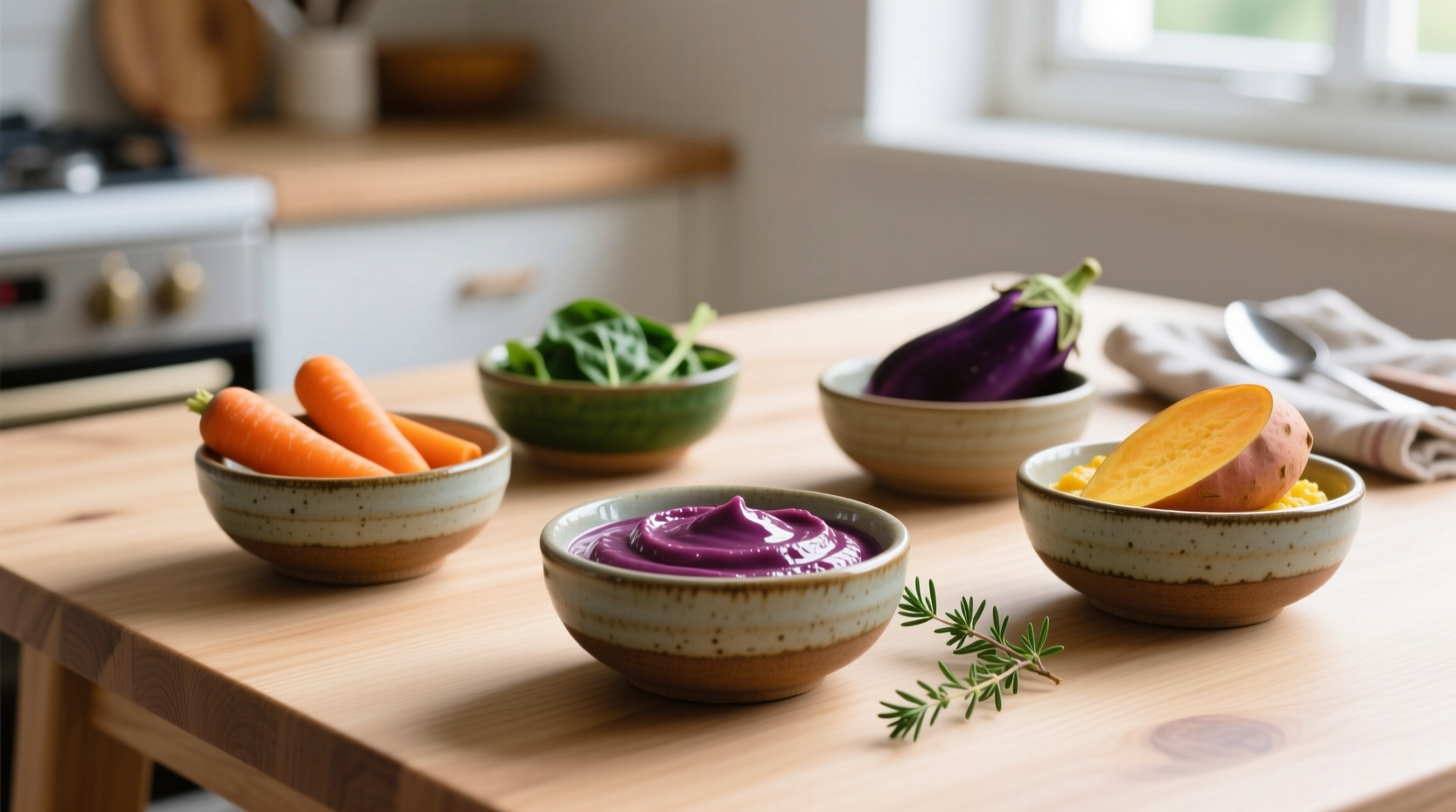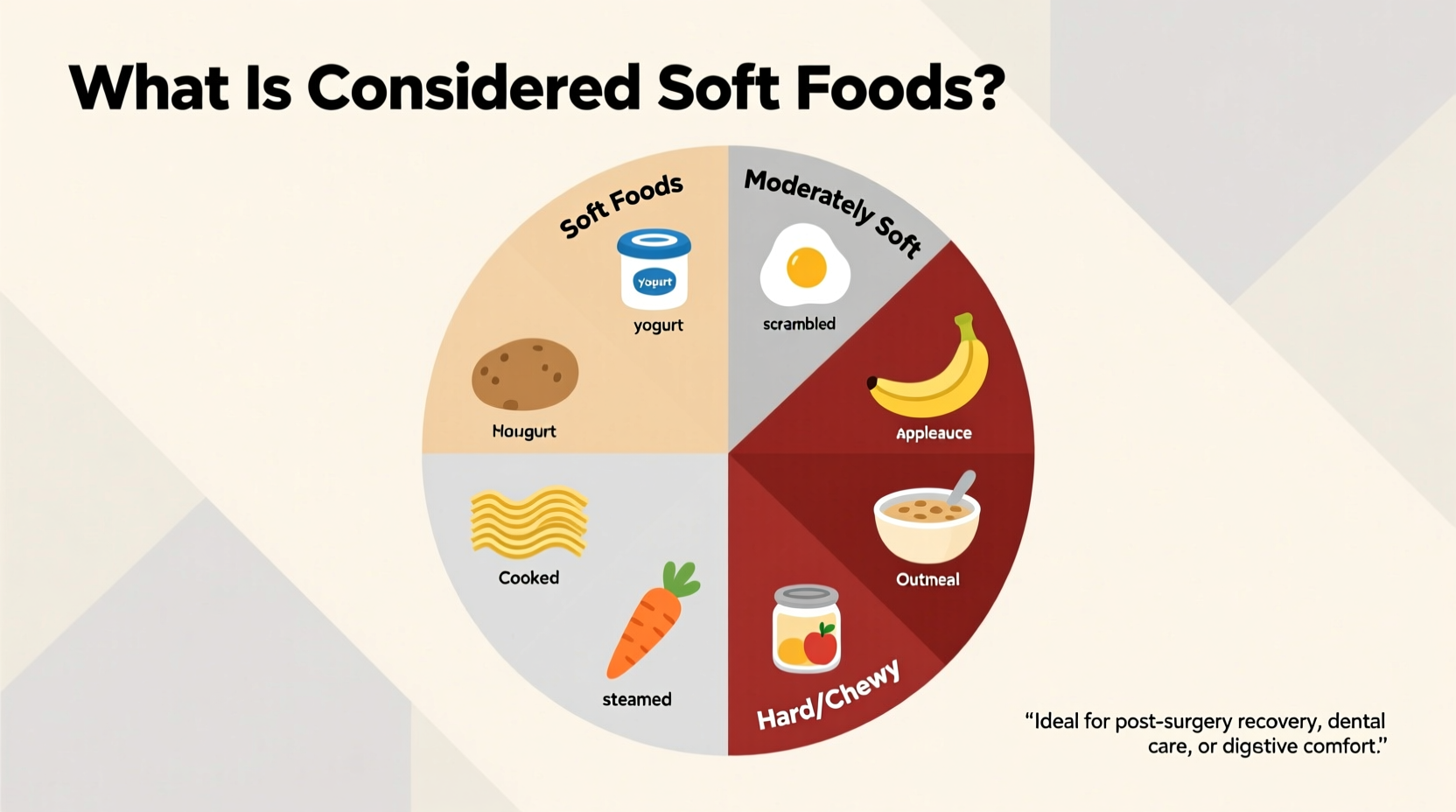Soft foods are easily chewed and swallowed items that require minimal or no chewing, typically with a smooth, mashed, or pureed texture. They're essential for people recovering from dental surgery, managing dysphagia, or following medical recommendations. This guide provides a comprehensive, medically-informed breakdown of soft food classifications, specific food examples, and practical preparation techniques backed by nutrition science.
Understanding Soft Food Classifications: More Than Just "Easy to Eat"
When your dentist says "stick to soft foods" after wisdom tooth extraction or your doctor recommends a mechanical soft diet for swallowing difficulties, they're referring to specific texture requirements—not just foods that feel soft. The International Dysphagia Diet Standardisation Initiative (IDDSI) provides the globally recognized framework with 8 texture levels, where Levels 3-7 specifically address soft food requirements:
| IDDSI Level | Texture Name | Key Characteristics | Common Uses |
|---|---|---|---|
| Level 3 | Liquidized | Smooth, no lumps, flows readily | Severe dysphagia, immediate post-surgery |
| Level 4 | Pureed | Homogeneous, very cohesive, minimal chewing | Dental surgery recovery, moderate dysphagia |
| Level 5 | Minced & Moist | Soft, wet, ¼-inch pieces, minimal chewing | Post-oral surgery, mild dysphagia |
| Level 6 | Soft & Bite-Sized | 1/2-inch pieces, requires some chewing | Transitioning from pureed diets |
| Level 7 | Easily Chewable | Normal texture with modified hardness | Dental work recovery, elderly nutrition |
This standardized system matters because inconsistent terminology like "soft" or "mashed" has caused dangerous misunderstandings in healthcare settings. According to research published by the International Dysphagia Diet Standardisation Initiative, implementing these standards reduced aspiration pneumonia incidents by 37% in long-term care facilities.
Your Complete Soft Food Reference Guide
Don't rely on vague "soft food" lists that include problematic items like peanut butter (a major choking hazard). Instead, use this medically-reviewed categorization based on IDDSI standards and Mayo Clinic dietary guidelines:
Fruits & Vegetables That Meet Soft Food Requirements
- Level 4 (Pureed): Applesauce (no chunks), mashed bananas, pureed pumpkin, cooked carrots blended to smooth consistency
- Level 5 (Minced): Canned peaches (drained and finely chopped), well-cooked zucchini diced to ¼-inch pieces, avocado mashed with fork
- Level 6 (Soft Bite-Sized): Seedless watermelon cut in ½-inch cubes, roasted sweet potato in small pieces, canned pears
Proteins That Actually Qualify as Soft Foods
- Fish & Seafood: Flaked salmon, tuna salad with finely chopped celery, pureed white fish
- Poultry & Meat: Shredded chicken breast (boiled or slow-cooked), meatloaf made with fine breadcrumbs, ground turkey cooked in broth
- Plant-Based: Silken tofu, hummus (smooth variety), refried beans (no whole beans)

Critical Foods That Don't Qualify as Soft (Despite Common Misconceptions)
Many "soft food" lists circulating online include dangerous items. The American Dental Association specifically warns against these seemingly soft but problematic foods:
- Peanut butter: Creates sticky clumps that are difficult to swallow (high aspiration risk)
- White bread: Forms a gummy paste when mixed with saliva, obstructing swallowing
- Steamed vegetables with skins: Tomato skins, potato skins, and cucumber skins resist breakdown
- Chunky soups: Unless specifically pureed, contain hazardous texture variations
According to the American Dental Association, 68% of post-extraction complications stem from patients consuming foods they mistakenly believed were "soft enough." Always check food textures against the IDDSI flow test—Level 4 purees should pour like light cream, not hold their shape like pudding.
Special Considerations for Different Medical Situations
Dental Surgery Recovery Timeline
Your soft food requirements change dramatically during recovery. The Academy of Oral and Maxillofacial Surgeons recommends this progression:
- Days 1-3: Only Level 3 (liquidized) foods—think smoothies with no pulp, broth-based soups
- Days 4-7: Transition to Level 4 (pureed)—mashed potatoes, pureed vegetables
- Weeks 2-3: Introduce Level 5 (minced) foods—finely chopped scrambled eggs, soft-cooked pasta
- Week 4+: Gradually incorporate Level 6-7 foods as healing progresses
Critical reminder: Avoid straws for at least 7 days after tooth extraction. Suction can dislodge blood clots and cause dry socket, increasing recovery time by 10-14 days according to American Association of Oral and Maxillofacial Surgeons data.
Dysphagia Management Essentials
For swallowing difficulties, texture modification isn't optional—it's medically necessary. The National Institute on Deafness and Other Communication Disorders (NIDCD) reports that properly modified soft food diets reduce aspiration pneumonia risk by 52% in at-risk populations. Key considerations:
- Thicken liquids to appropriate levels (honey-thick, pudding-thick) using commercial thickeners
- Test food textures with the fork pressure test: Level 4 purees should fall off a fork without pressure
- Never mix texture levels in one meal (e.g., pureed soup with solid crackers)
Practical Soft Food Preparation Techniques
Transform ordinary ingredients into safe soft foods with these chef-developed methods:
The Professional Pureeing Method
- Cook vegetables until extremely tender (longer than usual)
- Add minimal liquid (broth or water) to aid blending
- Blend in small batches using high-powered blender
- Strain through fine mesh sieve to remove any fibrous bits
- Adjust consistency with additional liquid as needed
Protein Tenderizing Secrets
- Use natural tenderizers: pineapple juice, papaya, or kiwi puree contain enzymes that break down proteins
- Cook meats using sous vide (precise temperature control) for maximum tenderness
- Shred rather than chop—creates smaller, more uniform pieces
Nutritional Balance on Soft Food Diets
Soft food diets often lack fiber, protein, and certain vitamins. Prevent nutritional deficiencies with these strategies:
- Add protein powder to smoothies (choose unflavored varieties to avoid texture changes)
- Incorporate pureed beans and lentils into soups and sauces
- Use vegetable purees as bases for sauces to boost vitamin content
- Choose nutrient-dense soft foods like avocado, Greek yogurt, and silken tofu
The Academy of Nutrition and Dietetics emphasizes that soft food diets shouldn't be nutritionally inferior—they should be differently prepared versions of balanced meals. Work with a registered dietitian to ensure you're meeting all nutritional requirements during extended soft food periods.
When to Consult a Professional
While soft food diets are often temporary, persistent swallowing difficulties require medical evaluation. Consult a healthcare provider if you experience:
- Frequent coughing or choking while eating
- Pain that lasts more than 7-10 days after dental procedures
- Unintended weight loss during soft food diet periods
- Difficulty swallowing both solids AND liquids
A speech-language pathologist can perform a formal swallowing evaluation (videofluoroscopic swallow study) to determine the appropriate texture modifications for your specific needs.
Soft Food Diet FAQs
Can I eat scrambled eggs on a soft food diet?
Yes, well-cooked scrambled eggs are an excellent soft food option (IDDSI Level 5-6). For optimal texture, cook them slowly over low heat with a small amount of milk or cream, stirring constantly until very soft and moist. Avoid browning or firm edges, which make them harder to chew and swallow.
How long should I stay on a soft food diet after wisdom teeth removal?
Most oral surgeons recommend 7-10 days of strict soft foods after wisdom tooth extraction. Days 1-3 should be liquidized (Level 3), days 4-7 pureed (Level 4), and days 8-10 minced/soft bite-sized (Level 5-6). Complete healing takes 2-3 weeks, during which you should gradually reintroduce firmer foods while avoiding anything crunchy, chewy, or requiring front tooth use.
Are smoothies considered soft foods?
Only smoothies without chunks, seeds, or pulp qualify as soft foods. For Level 3 (liquidized), strain smoothies through a fine mesh sieve to remove all fibrous material. Avoid ingredients like chia seeds, flax seeds, or fruit chunks that create texture variations. Use soft fruits like bananas, mango, and cooked apples rather than raw berries or apples.
What's the difference between a soft food diet and a mechanical soft diet?
A standard soft food diet focuses on foods naturally soft in texture, while a mechanical soft diet specifically modifies food textures through processing (blending, mashing, grinding) to meet medical requirements. Mechanical soft diets follow standardized texture levels (like IDDSI), whereas general soft food recommendations often lack precise texture specifications. Medical professionals typically prescribe mechanical soft diets for swallowing disorders.
Can I make soft food meals flavorful without using hard spices?
Absolutely. Use infused oils (garlic or herb-infused olive oil), smooth spice pastes (turmeric paste, ginger paste), citrus zest, and liquid seasonings like soy sauce or vinegar. Toast spices before blending them into sauces to maximize flavor release. Fresh herb purees (basil, cilantro) add vibrant flavor without texture issues. Avoid whole spices, seeds, or coarse spice blends that create texture inconsistencies.











 浙公网安备
33010002000092号
浙公网安备
33010002000092号 浙B2-20120091-4
浙B2-20120091-4